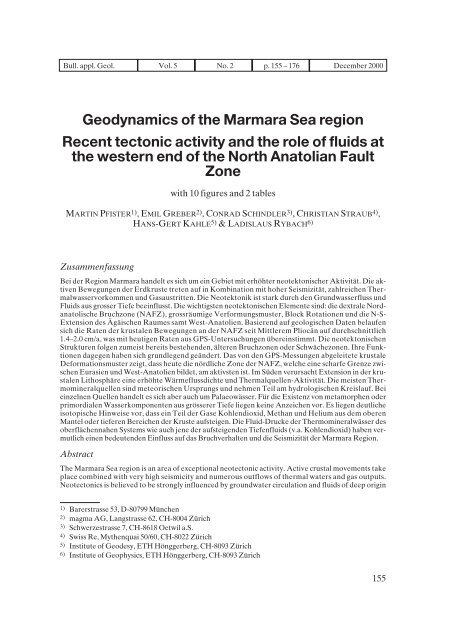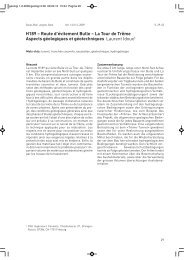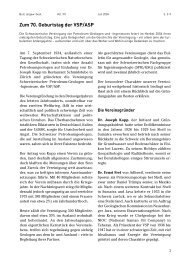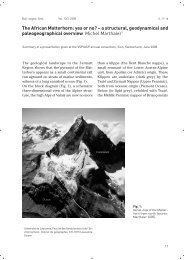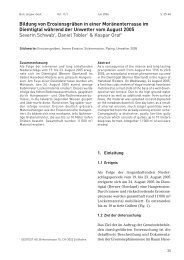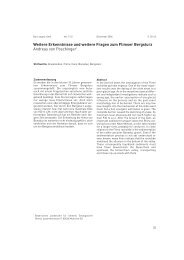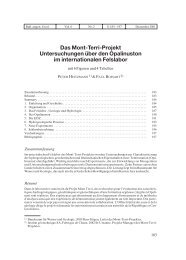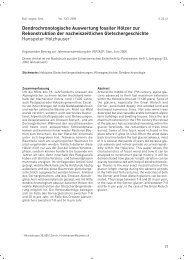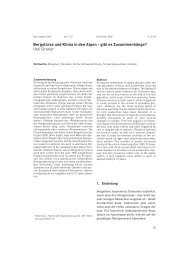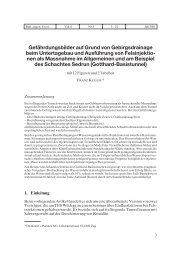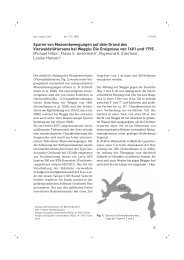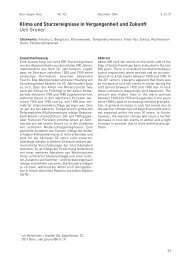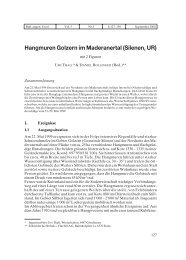Geodynamics of the Marmara Sea region Recent tectonic activity ...
Geodynamics of the Marmara Sea region Recent tectonic activity ...
Geodynamics of the Marmara Sea region Recent tectonic activity ...
You also want an ePaper? Increase the reach of your titles
YUMPU automatically turns print PDFs into web optimized ePapers that Google loves.
Bull. appl. Geol. Vol. 5 No. 2 p. 155 – 176 December 2000<br />
<strong>Geodynamics</strong> <strong>of</strong> <strong>the</strong> <strong>Marmara</strong> <strong>Sea</strong> <strong>region</strong><br />
<strong>Recent</strong> <strong>tectonic</strong> <strong>activity</strong> and <strong>the</strong> role <strong>of</strong> fluids at<br />
<strong>the</strong> western end <strong>of</strong> <strong>the</strong> North Anatolian Fault<br />
Zone<br />
with 10 figures and 2 tables<br />
MARTIN PFISTER 1) , EMIL GREBER 2) , CONRAD SCHINDLER 3) , CHRISTIAN STRAUB 4) ,<br />
HANS-GERT KAHLE 5) & LADISLAUS RYBACH 6)<br />
Zusammenfassung<br />
Bei der Region <strong>Marmara</strong> handelt es sich um ein Gebiet mit erhöhter neotektonischer Aktivität. Die aktiven<br />
Bewegungen der Erdkruste treten auf in Kombination mit hoher Seismizität, zahlreichen Thermalwasservorkommen<br />
und Gasaustritten. Die Neotektonik ist stark durch den Grundwasserfluss und<br />
Fluids aus grosser Tiefe beeinflusst. Die wichtigsten neotektonischen Elemente sind: die dextrale Nordanatolische<br />
Bruchzone (NAFZ), grossräumige Verformungsmuster, Block Rotationen und die N-S-<br />
Extension des Ägäischen Raumes samt West-Anatolien. Basierend auf geologischen Daten belaufen<br />
sich die Raten der krustalen Bewegungen an der NAFZ seit Mittlerem Pliocän auf durchschnittlich<br />
1.4–2.0 cm/a, was mit heutigen Raten aus GPS-Untersuchungen übereinstimmt. Die neotektonischen<br />
Strukturen folgen zumeist bereits bestehenden, älteren Bruchzonen oder Schwächezonen. Ihre Funktionen<br />
dagegen haben sich grundlegend geändert. Das von den GPS-Messungen abgeleitete krustale<br />
Deformationsmuster zeigt, dass heute die nördliche Zone der NAFZ, welche eine scharfe Grenze zwischen<br />
Eurasien und West-Anatolien bildet, am aktivsten ist. Im Süden verursacht Extension in der krustalen<br />
Lithosphäre eine erhöhte Wärmeflussdichte und Thermalquellen-Aktivität. Die meisten Thermomineralquellen<br />
sind meteorischen Ursprungs und nehmen Teil am hydrologischen Kreislauf. Bei<br />
einzelnen Quellen handelt es sich aber auch um Palaeowässer. Für die Existenz von metamorphen oder<br />
primordialen Wasserkomponenten aus grösserer Tiefe liegen keine Anzeichen vor. Es liegen deutliche<br />
isotopische Hinweise vor, dass ein Teil der Gase Kohlendioxid, Methan und Helium aus dem oberen<br />
Mantel oder tieferen Bereichen der Kruste aufsteigen. Die Fluid-Drucke der Thermomineralwässer des<br />
oberflächennahen Systems wie auch jene der aufsteigenden Tiefenfluids (v.a. Kohlendioxid) haben vermutlich<br />
einen bedeutenden Einfluss auf das Bruchverhalten und die Seismizität der <strong>Marmara</strong> Region.<br />
Abstract<br />
The <strong>Marmara</strong> <strong>Sea</strong> <strong>region</strong> is an area <strong>of</strong> exceptional neo<strong>tectonic</strong> <strong>activity</strong>. Active crustal movements take<br />
place combined with very high seismicity and numerous outflows <strong>of</strong> <strong>the</strong>rmal waters and gas outputs.<br />
Neo<strong>tectonic</strong>s is believed to be strongly influenced by groundwater circulation and fluids <strong>of</strong> deep origin<br />
1) Barerstrasse 53, D-80799 München<br />
2) magma AG, Langstrasse 62, CH-8004 Zürich<br />
3) Schwerzestrasse 7, CH-8618 Oetwil a.S.<br />
4) Swiss Re, My<strong>the</strong>nquai 50/60, CH-8022 Zürich<br />
5) Institute <strong>of</strong> Geodesy, ETH Hönggerberg, CH-8093 Zürich<br />
6) Institute <strong>of</strong> Geophysics, ETH Hönggerberg, CH-8093 Zürich<br />
155
in this area. The main neo<strong>tectonic</strong> elements can be defined as: <strong>the</strong> dextral North Anatolian Fault Zone<br />
(NAFZ), <strong>region</strong>al faulting and tilting, block rotations, and <strong>the</strong> N-S extension <strong>of</strong> <strong>the</strong> Aegean realm including<br />
westernmost Anatolia. Since Middle Pliocene, rates <strong>of</strong> crustal movement along <strong>the</strong> NAFZ have<br />
averaged 1.4–2.0 cm/y based on geological data, close to <strong>the</strong> present rate <strong>of</strong> 2.2 cm/y determined from<br />
GPS (Global Positioning System) investigations. The neo<strong>tectonic</strong> structures mostly follow pre-existing<br />
faults or zones <strong>of</strong> weakness. Their function, however, has changed completely. The GPS-derived crustal<br />
deformation pattern shows that <strong>the</strong> nor<strong>the</strong>rn zone <strong>of</strong> <strong>the</strong> NAFZ is most active today, forming a sharp<br />
boundary between Eurasia and Western Anatolia. To <strong>the</strong> south, extension <strong>of</strong> continental lithosphere elevates<br />
terrestrial heat flow density and <strong>the</strong>rmal spring <strong>activity</strong>. Most <strong>of</strong> <strong>the</strong> <strong>the</strong>rmo-mineral waters are <strong>of</strong><br />
meteoric origin and part <strong>of</strong> <strong>the</strong> modern hydrologic cycle, some are paleowaters. No evidence exists for<br />
involvement <strong>of</strong> metamorphic or primordial waters. Isotopic evidence suggests that carbon dioxide,<br />
methane and helium partly ascend from <strong>the</strong> upper mantle and lower crustal levels. The fluid pressures <strong>of</strong><br />
<strong>the</strong> shallow <strong>the</strong>rmo-mineral waters as well as <strong>of</strong> <strong>the</strong> deep-seated carbon dioxide probably play an important<br />
role in fault behavior and seismicity in <strong>the</strong> <strong>Marmara</strong> <strong>Sea</strong> <strong>region</strong>.<br />
1. Introduction<br />
The North Anatolian Fault Zone (NAFZ) forms <strong>the</strong> <strong>tectonic</strong> connection between<br />
<strong>the</strong> East Anatolian convergent zone and <strong>the</strong> Hellenic Arc, where <strong>the</strong> motion <strong>of</strong><br />
Asia Minor is compensated by <strong>the</strong> consumption <strong>of</strong> oceanic crust (McKenzie 1972).<br />
The eastern part <strong>of</strong> <strong>the</strong> NAFZ is a narrow strike-slip zone, whereas fur<strong>the</strong>r in <strong>the</strong><br />
west, in <strong>the</strong> <strong>Marmara</strong> <strong>Sea</strong> <strong>region</strong>, <strong>the</strong> NAFZ splits into a complex fault pattern (Fig.<br />
1). This branching is caused by <strong>the</strong> transition <strong>of</strong> <strong>the</strong> pure strike-slip regime in <strong>the</strong><br />
east into a stress regime with additional N-S extension. The latter is typical for <strong>the</strong><br />
Aegean <strong>region</strong> and responsible for <strong>the</strong> predominant E-W oriented graben structures<br />
in Western Anatolia.<br />
In this paper, we describe <strong>the</strong> neo<strong>tectonic</strong> <strong>activity</strong> <strong>of</strong> <strong>the</strong> <strong>Marmara</strong> <strong>Sea</strong> <strong>region</strong>. We<br />
especially focus on <strong>the</strong> interaction <strong>of</strong> neo<strong>tectonic</strong>s with groundwater circulation<br />
and fluids <strong>of</strong> deep origin (CO 2 , He, CH 4 , N 2 ) and <strong>the</strong>n compare our findings with<br />
<strong>the</strong> situation along <strong>the</strong> San Andreas Fault System (SAFS).<br />
The present work develops new aspects <strong>of</strong> <strong>the</strong> MARMARA Polyproject (Schindler<br />
& Pfister 1997).<br />
2. Seismicity<br />
In <strong>the</strong> <strong>Marmara</strong> <strong>Sea</strong> <strong>region</strong>, historic seismic <strong>activity</strong> is prominent (Ambraseys &<br />
Finkel 1991); many devastating earthquakes have occurred along <strong>the</strong> NAFZ. The<br />
instrumentally covered period shows that in <strong>the</strong> last decades seismicity <strong>of</strong> Western<br />
Anatolia has been highly active. Detailed investigations <strong>of</strong> low-magnitude earthquakes<br />
reveal swarm-type <strong>activity</strong> with remarkable clustering in space and time<br />
(Ücer et al. 1985, 1997, Sellami et al. 1997). The fault mechanisms <strong>of</strong> strong earthquakes<br />
are associated with major <strong>tectonic</strong> structures (Jackson & McKenzie 1988,<br />
Papazachos & Kiratzi 1996). According to various bulletins and sources <strong>the</strong> focal<br />
depths <strong>of</strong> <strong>the</strong> earthquakes range from 0 to 50 km. More accurate localization <strong>of</strong> selected<br />
earthquakes suggest focal depths no deeper than 10 to 15 km (e.g. Eyidogan<br />
& Jackson 1985). In <strong>the</strong> Bursa <strong>region</strong>, Sellami et al. (1997) located 90 % <strong>of</strong> <strong>the</strong> lowmagnitude<br />
earthquakes in <strong>the</strong> uppermost 15 km, and only few earthquakes with<br />
depths between 15 and 60 km.<br />
Based on <strong>the</strong> epicenters distribution <strong>of</strong> Western Anatolia, Crampin & Evans (1986)<br />
156


